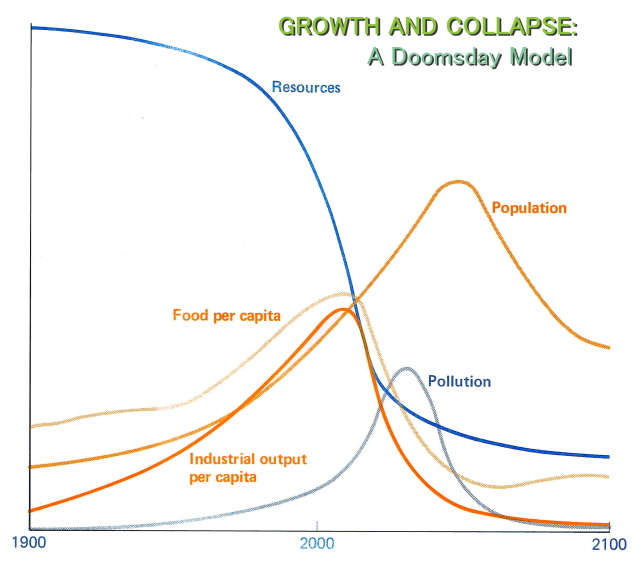Doomsday Model of Economic Growth
Back in the 1970s, an elite group of scientists, researchers and consultants had researched and debated about the
future growth of the world economy, using computer models developed at MIT.
The models assumed no major change in the physical, economic, or social relationships that governed
the civilization for the last 100 years. As the world population grew exponentially from 1900 to the middle of the 21st Century,
the growth trends in industrial output, food production, pollution and resource depletion would also increase correspondingly.
There would be a time lag among the peaks of these trends. The industrial output, food production and resource depletion
would come to their peaks first, and later the pollution, and then finally the population, as shown in the figure.

One research model concluded (Meadows)
"If the present growth trends in world population, industrialization, pollution, food production, and resource
depletion continue unchanged, the limits to growth on this planet will be reached sometime within the next one hundred years.
The most probable result will be a rather sudden and uncontrollable decline in both population and industrial capacity."
Other models with more optimistic assumptions also ended with a similarly dismal conclusion —
The exponential growth of population and capital would be followed by collapse.
If the depletion of natural resources did not bring about collapse, then famine and pollution would.
The elite group proposed zero growth of population and economy ( a state of stagnation)
to achieve equilibrium to halt the catastrophic collision course with production limits
imposed by natural resources and the pollution-absorbing capacity of the environment.
The opponents to the Doomsday Models, however, pointed out that our economy would :
1. Efficiently and effectively to apply existing knowledge in production.
2. To make progress in technologies to increase the supply of natural resources:
3. To expand the output production levels obtainable from the limited resources by using new materials.
4. To generate new knowledge from existing knowledge.
5. To adapt to changes in the environment and the economy.
Comments
Looking back to the past 50 years, the predictions by the Doomsday Models
seems to be basically fitting the reality. The industrial output is still expanding
especially for the developing countries, such as China, India and Brazil; however,
the GDP growth for western countries is now stalling and short of capital after
a severe financial crises in 2008. There are no global famine as biotechnical progress
and industrialization in agriculture have provided higher yields, although the capital countries from Middle East and
Asia are yearning for agricultural lands in Africa. Pollution (air and land) are improving in developed countries,
but the qualities of sea water are now deteriorating rapidly. Resources in minerals,
energy and renewable natural stocks with the exception of fresh water are still keeping up
with the demands due to new explorations and extraction techniques by
resource industries and the recycling efforts and more efficient usage of resources.
The world population is still growing remarkably - 4.5 billion in 1980, 5.3 billion in 1990, 6 billion in 1999.
According to US Census Bureau, the world has more than 7.056895 billions of people on January 1, 2013.
Thus, one has to be an optimist to brave the future and hope the changes in growth trends,
the developments in technological progress and the social behaviours will fend off challenges in the world.
References
1. Meadows, Dennis, and |others: The Limits to Growth, Potomac Associates, Washington, 1972.2. McConnell, C.R., Economics: Principles, Problems and Policies, McCraw-Hill Book Co., 8th Edition, 1981, pp. 403-408.
[Top|Middle] of Page